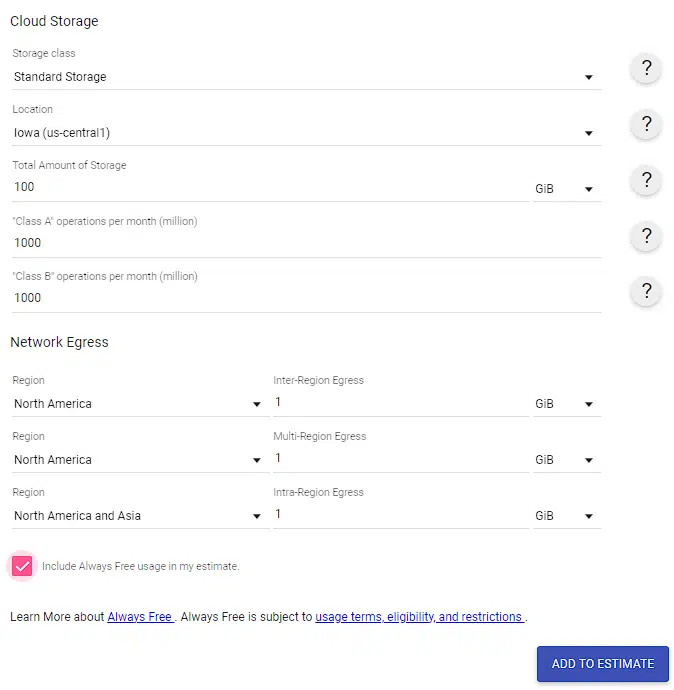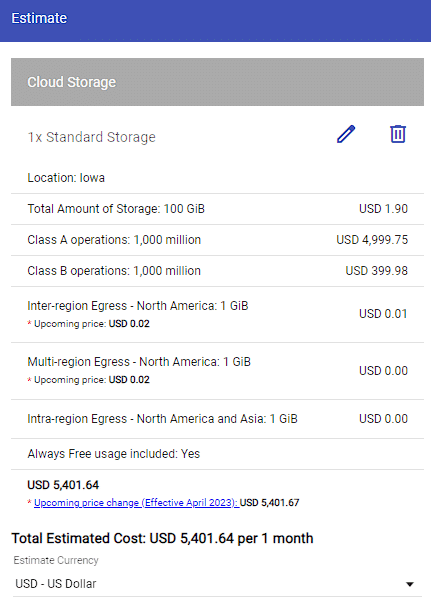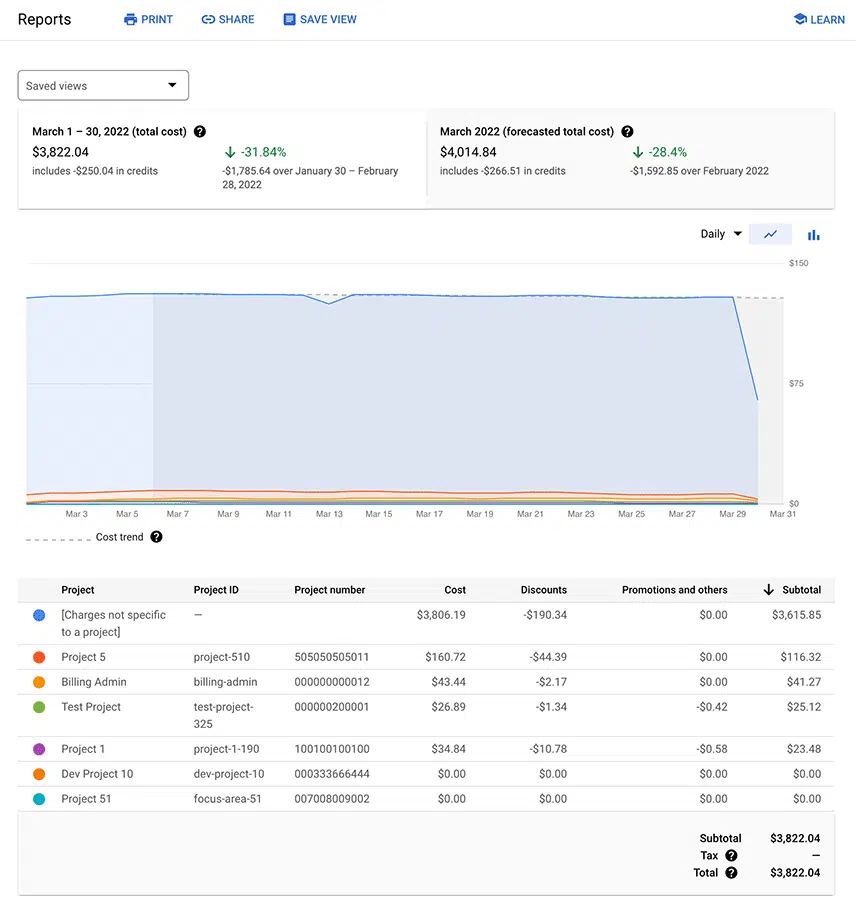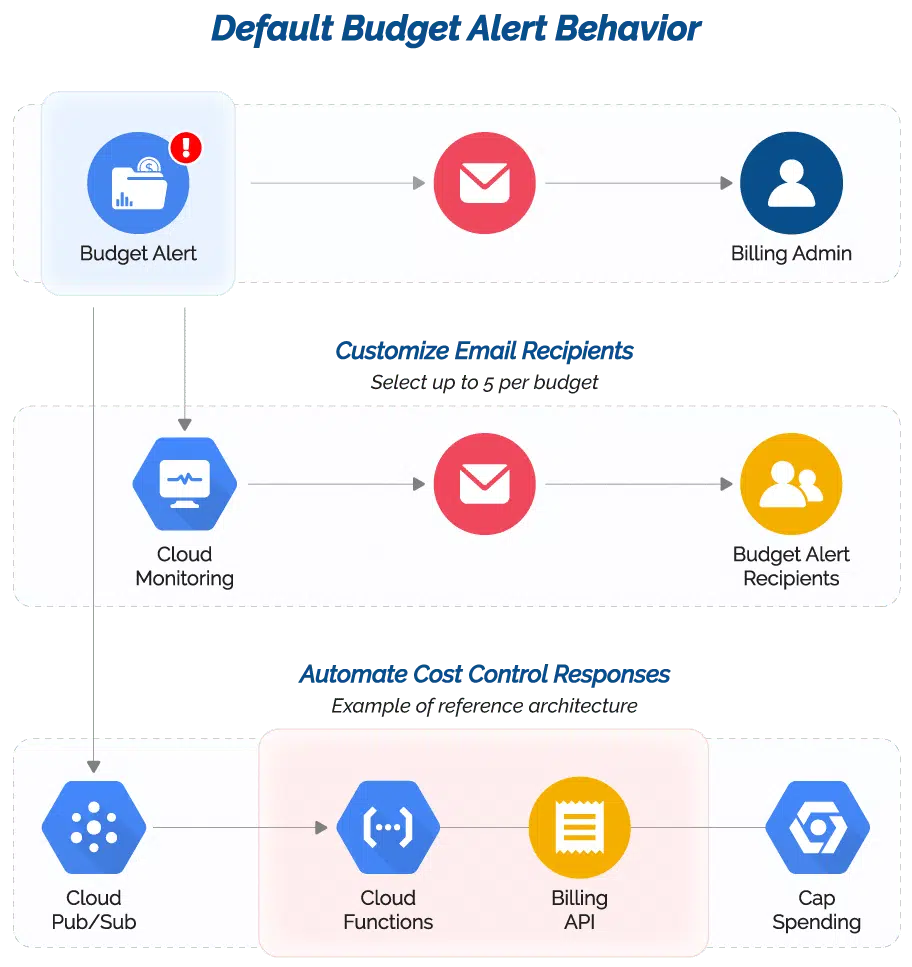GCP cost management involves setting up monitoring tools and defining the appropriate response for each billing scenario. Google Cloud has several built-in monitoring tools, such as cloud billing reports, CUD analysis reports, and more. These help users stay aware of the organization’s cloud spending.
Users must also set up response mechanisms for various billing scenarios. For example, if spending has reached a limit, a possible response is that all services that incur costs must stop temporarily. Setting up these response systems is possible by leveraging low-cost services on Google Cloud like Pub/Sub and Cloud Functions.
This article offers a tutorial for using GCP’s native tooling functionality and leaves off with a recommendation for optimizing costs across multiple cloud providers (e.g., GCP, AWS, Azure) using a third-party tool that can automatically take actions.
Summary of key GCP cost management concepts
The following are the key concepts that will be discussed in the article:
| Key Concept | Description | |
|---|---|---|
| 1 | Cost calculator | This calculator with up-to-date prices is usually an excellent starting point for cost estimation. |
| 2 | Sustained-use discounts | These discounts are automatically applied to instances running for at least 25% of the month. |
| 3 | Committed-use discounts | With these discounts, the user commits to a one-year or three-year contract. |
| 4 | Resource-based committed use discounts (CUD) | These are discounts where the user commits to use a minimum amount of resources. |
| 5 | Spend-based committed use discounts (CUD) | With these discounts, the user commits to a minimum spend level. |
| 6 | Spot instances | These are VM instances that use shared resources that can be preempted at any time. |
| 7 | Cloud billing reports | These reports show current cost trends and forecasted costs based on past data. |
| 8 | Alerts | Alerts are Google Cloud’s built-in notification system that fires off once billing thresholds are reached. |
There are two main elements in cost management: savings and monitoring.
To manage costs, users must be smart about maximizing savings. Google Cloud has several savings vehicles that reward users with discounts. However, users must deeply understand their environment and long-term goals to determine the right savings vehicles to use. Some examples of savings vehicles include discounts and spot instances.
Monitoring aids users in understanding their resources by providing essential metrics. These tools allow users to make sound business decisions based on accurate data. Some examples of monitoring tools include cloud billing reports, quotas, and alerts.

See the best multi-cloud management solution on the market, and when you book & attend your CloudBolt demo we’ll send you a $75 Amazon Gift Card.
Cost Calculator
The Google Cloud Pricing Calculator estimates usage costs. Technical architects often use this tool to project costs based on possible configurations. It is straightforward to use and always up to date with the latest prices.
For example, below are the steps to get the costs for a Cloud Storage bucket.
First, find the particular service you would like to estimate. In this case, we are interested in Cloud Storage:

Fill out the configuration details. Note that the configuration will differ for each service. Once done, hit Add to estimate.

Once completed, you will see the item added to the overall estimate. All other items will also appear in the summary, and the total monthly cost will be computed on the fly.

Discounts
GCP has several savings vehicles that contribute to reducing costs without reducing performance and scalability. There are two main discounts: Sustained-use discounts are automatically applied to running Compute Engine instances, while committed-use discounts are based on a one-year or three-year commitment; naturally, the longer commitment offers the deepest discount.
Sustained-use discounts
These are automatically applied to Compute Engine instances that are used for more than 25% of the month. The longer an instance is used, the deeper the discount. The discount table is as follows:
| Different Usage Levels of Sustained-Use Discounts | |||
| Maximum discount | Applicable resources | Usage level | Incremental charge (%) relative to on-demand rate |
|---|---|---|---|
| 30% | General-purpose N1 and custom machine types, memory-optimized machine types, shared-core machine types, and sole-tenant nodes | 0-25% | 100% |
| 25-50% | 80% | ||
| 50-75% | 60% | ||
| 75-100% | 40% | ||
| 20% | General-purpose N2 and N2D predefined and custom machine types and Compute-optimized machine types | 0-25% | 100% |
| 25-50% | 86.78% | ||
| 50-75% | 73.3% | ||
| 75-100% | 60% | ||

|
Platform
|
Multi Cloud Integrations
|
Cost Management
|
Security & Compliance
|
Provisioning Automation
|
Automated Discovery
|
Infrastructure Testing
|
Collaborative Exchange
|
|---|---|---|---|---|---|---|---|
|
CloudHealth
|
✔
|
✔
|
✔
|
||||
|
Morpheus
|
✔
|
✔
|
✔
|
||||
|
CloudBolt
|
✔
|
✔
|
✔
|
✔
|
✔
|
✔
|
✔
|
Committed-use discounts
CUDs are one-year or three-year contracts that are ideal for predictable and consistent long-term workloads, allowing users to secure a 57-70% discount. Keep in mind that sustained-use discounts and CUDs are separate discounts that can be applied simultaneously, increasing the overall savings.
There are two types of CUDs: resource-based and spend-based.
Resource-based committed-use discounts
These CUDs apply exclusively to Compute Engine instances and state that the user will have to commit to using a certain number of resources for the agreed-upon timeframe. The actual discounts will vary based on the machine type.
Spend-based committed-use discounts
These CUDs apply to the following services: Cloud SQL, Cloud Spanner, Google Cloud VMWare Engine, Cloud Run, and Kubernetes Engine. In contrast to the resource-based CUD, this depends on a commitment of dollars spent. Users must hit the agreed-upon cost amount before discounts are granted. Any amount over the contract amount will be billed at an on-demand rate.
Spot instances
Spot VMs are machines that offer 60-91% discounts in exchange for allowing the system to preempt them at any time. These are perfect for stateless and fault-tolerant workloads. Any process that can be accomplished without relying on states should ideally run on spot VMs.
Cloud billing reports
This is the main reporting tool in Google Cloud that presents a summary of charges for every billing period. Additionally, it will also show forecasted spending based on past data. It is an excellent tool for gaining visibility into the overall financial health of a project. It answers questions such as these:
- Are we over or under budget?
- What resources do we need to adjust?
- Are we spending more or less than the last billing period?
- How effective are the discounts at curbing costs?
Here is a sample billing dashboard.

Alerts
Alerts are sub-tools of Google Cloud monitoring that are useful for informing users about possible issues. Users can define alerting policies based on either metrics or logs. The former relies on metrics like resource uptime, load, etc., whereas the latter depends on specific log messages. Alerts do not incur costs, but they have usage limits.
A sample use case follows: A Compute Engine instance is hosting a web application. If there is a latency of more than 2 seconds for at least 5 minutes, an alert will be sent to support engineers via email, Slack, and SMS.
Budget alerts are designed to inform users if they are approaching the budget limit. Users can create budgets by setting the budget scope. In addition:
- Budget alerts can apply the policy to a billing account or specific projects and services.
- The budget amount can be set to a particular number or a number based on the previous billing period.
- Setting threshold rules and actions defines the budget percentage at which an alert will be triggered and a notification sent to specific recipients. Budget alerts can be sent via email or to a Pub/Sub topic for programmatic integration.

Recommendations
Here are the recommended best practices to optimize cost management strategies.
Estimate and adjust cloud costs using monitoring
Leverage cloud monitoring tools like cloud billing reports to get a clear picture of how an environment performs on average and peak days. The cost incurred in a billing period and forecasted prices for the current billing period indicate whether or not some adjustment is in order.
Use this data to answer critical questions:
- Which projects and services cost the most and when?
- What unused instances can be terminated?
- Do some resources need to be downsized or upsized?
- Are the discounts being maximized?
Those insights will help you understand if there are areas where you can potentially save more or make adjustments to reduce cost without sacrificing performance.
Leverage committed-use discounts and spot instances
In cases where an environment is intended to be used for the long term, it is prudent to sign up for committed-use discounts. This is because these contracts promise deep discounts on top of sustained-use discounts. Use spot instances instead of regular Compute Engine instances for fault-tolerant workloads, as the discounts can save a lot of money. If possible, architect your workflows to enable stateless workloads to make spot instances leverageable.
Design a budget allocation plan and set budget alerts
A budget plan helps users understand how much can be spent for each project. For instance, you can have a total budget for a billing account and one for each project and service group. Then, set alerts for each item. A simple yet effective sample budget plan is as follows:
| Scope | Budget per month | Threshold |
|---|---|---|
| Billing account | $1,000 | 90% |
| Project-1 | $400 | 70% |
| Project-2 | $600 | 70% |
| Project-1-compute-engine | $350 | 90% |
| Project-1-cloud-storage | $50 | 90% |
| Project-2-dataflow | $200 | 90% |
| Project-2-cloud-sql | $400 | 90% |
With this budget plan, users will not be blindsided by billing costs in case there are spikes in usage. Additionally, they can take action to halt or downgrade services as needed without spending money unnecessarily.
Export cloud monitoring data to create custom budget dashboards
Google Cloud’s suite of native monitoring tools offers metrics that can easily be exported to create custom budget dashboards. Leverage this functionality to create budget dashboards that offer insights at a glance to make decision-making fast and accurate. Though there are many monitoring tools, no unified dashboard aggregates all metrics.
Use third-party tools to manage costs consistently across cloud providers
GCP’s native tooling is limited to one public cloud platform; however, most companies have adopted a hybrid and multi-cloud strategy. Modern tools like CloudBolt offer functionality in multiple domains (configuration, automation, compliance, cost management) in the form of single integrated solution – and integrate across all major cloud providers while also covering private cloud environments.
CloudBolt’s Accelerate Cost Optimization tool is one of the best ways to monitor costs consistently across multiple cloud providers (like AWS and Azure), view consolidated cost allocation reports, and automatically take action to remove waste. It takes the burden of cost management away from users and enables businesses to focus on what truly matters: delivering world-class products and services.
Conclusion
Staying on top of cloud spending is increasingly vital since costs can quickly balloon when left unattended. Businesses can potentially lose money in cases where cost is mismanaged. Hence, it is imperative to leverage cloud monitoring tools and cost estimates to craft a cohesive cost management plan.
Related Blogs

The End of Manual Optimization: Why We Acquired StormForge
Today is a big day for CloudBolt—we’ve officially announced our acquisition of StormForge. This marks a major milestone for us…



